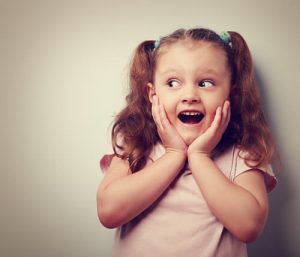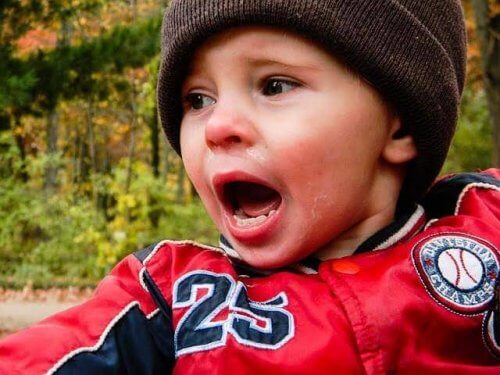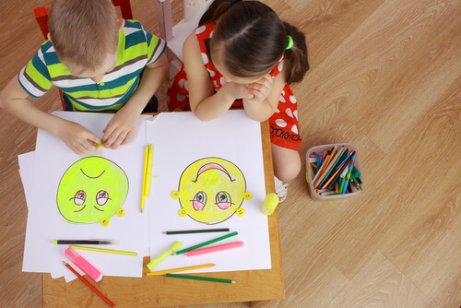Secondary Emotions and Their Appearance in Children

According to the classification that psychologist Paul Ekman created, primary emotions include joy, sadness, wrath, fear, grossness, loneliness and shock. The essential characteristic that all of these emotions have in common is that they’re universal and genetically predetermined. In other words, we know them from the time we’re born.
Danish physician Carl Lange and American psychologist William James also contributed to this field of study. They added the idea that emotions depend on two factors. First, they have to do with the physical changes that occur within our bodies in the face of stimuli. And second, the way we interpret them.
Researchers Stanley Schachter and Jerome Singer built their theory upon this idea. They state that our thoughts can also release an organic response and posterior release of a series of neurotransmitters. In the same way that our environment and other people can spark primary emotions, so can our thoughts.
What are secondary emotions?
Unlike the emotions listed above, secondary emotions are more complex. According to Ekman, these emotions are those that we produce as a result of our growth, interaction with others, and the combination of primary emotions.
Secondary emotions are also more difficult to identify than primary emotions. This means that we don’t always display them through gestures like a smile or an eyebrow raise, as we may do with happiness or surprise.
During the 1990’s, Ekman identified the following secondary emotions:
- Amusement
- Guilt
- Embarassment
- Contempt
- Contentment
- Excitement
- Pride in achievement
- Satisfaction
- Shame
- Relief
- Sensory pleasure
All of these secondary emotions have three things in common. They are all learned, mental and don’t fulfill any biological adaptive function.

The connection between secondary and primary emotions
Venezuelan psychologist Graciela Baugher made an interesting analysis on the subject. She states that secondary emotions express a problem in the mind that we must eliminate to avoid suffering consequences.
“Secondary emotions are those that we produce as a result of our growth, interaction with others, and the combination of primary emotions”
These emotions act as mental extensions of primary emotions. Over time, they can be detrimental to our health. For example, Baugher states that while fear can protect us at certain moments, when extended over time, fear can cause anxiety, phobias and panic.
The same is true with sadness. Sadness allows us to begin the process of recovery from a traumatic experience. However, if sadness is drawn out, it can produce depression and self-destructive tendencies.
Finally, Baguer states that something similar happens with happiness and pain. Happiness can lead to attachment or pleasure. Anger, over time, can lead to hate or resentment.
How do secondary emotions appear in children?
Being able to display emotion is a vital part of a child’s emotional development. The first phase involves learning to identity them.
In this regards, the stimulation of emotional intelligence is a fundamental step that parents can contribute to. How? Through exercises and practices that help children understand their emotions. These can include games, drawing and even cell phone applications.
Ekman based his work on the study of facial expressions. This is the first means through which we can detect the secondary emotions that a child possesses.
Once you perceive a determined emotion, or you suspect the presence of any of them, we highly suggest talking to your child. Putting feelings into words is one of the best ways to express emotions. This isn’t only true for children, but for adults as well.

In fact, not expressing one’s emotions can be more dangerous than you may think. Repressing emotions can lead to emotional and mental weakness, low self-esteem, lack of empathy and authenticity, and behavioral problems.
“The stimulation of emotional intelligence is a fundamental step that parents can contribute to”
Emotions and bad behavior
Behavioral issues, in fact, are another way in which children express their secondary emotions. Why? While behavioral issues can have to do with a child’s genetics and innate personality, it also has to do with upbringing. Bad behavior is a direct consequence of the education a child receives, including on an emotional level.
Children who hold in their negative emotions will end up having feelings of resentment and negativity. If a child expresses his or her emotions and isn’t met with proper support or attention, the situation is even worse.
It’s clear that parents play an incredibly important role in detecting their child’s emotions. But what’s more, they are responsible for teaching their children to express and handle those emotions in a healthy way.
According to the classification that psychologist Paul Ekman created, primary emotions include joy, sadness, wrath, fear, grossness, loneliness and shock. The essential characteristic that all of these emotions have in common is that they’re universal and genetically predetermined. In other words, we know them from the time we’re born.
Danish physician Carl Lange and American psychologist William James also contributed to this field of study. They added the idea that emotions depend on two factors. First, they have to do with the physical changes that occur within our bodies in the face of stimuli. And second, the way we interpret them.
Researchers Stanley Schachter and Jerome Singer built their theory upon this idea. They state that our thoughts can also release an organic response and posterior release of a series of neurotransmitters. In the same way that our environment and other people can spark primary emotions, so can our thoughts.
What are secondary emotions?
Unlike the emotions listed above, secondary emotions are more complex. According to Ekman, these emotions are those that we produce as a result of our growth, interaction with others, and the combination of primary emotions.
Secondary emotions are also more difficult to identify than primary emotions. This means that we don’t always display them through gestures like a smile or an eyebrow raise, as we may do with happiness or surprise.
During the 1990’s, Ekman identified the following secondary emotions:
- Amusement
- Guilt
- Embarassment
- Contempt
- Contentment
- Excitement
- Pride in achievement
- Satisfaction
- Shame
- Relief
- Sensory pleasure
All of these secondary emotions have three things in common. They are all learned, mental and don’t fulfill any biological adaptive function.

The connection between secondary and primary emotions
Venezuelan psychologist Graciela Baugher made an interesting analysis on the subject. She states that secondary emotions express a problem in the mind that we must eliminate to avoid suffering consequences.
“Secondary emotions are those that we produce as a result of our growth, interaction with others, and the combination of primary emotions”
These emotions act as mental extensions of primary emotions. Over time, they can be detrimental to our health. For example, Baugher states that while fear can protect us at certain moments, when extended over time, fear can cause anxiety, phobias and panic.
The same is true with sadness. Sadness allows us to begin the process of recovery from a traumatic experience. However, if sadness is drawn out, it can produce depression and self-destructive tendencies.
Finally, Baguer states that something similar happens with happiness and pain. Happiness can lead to attachment or pleasure. Anger, over time, can lead to hate or resentment.
How do secondary emotions appear in children?
Being able to display emotion is a vital part of a child’s emotional development. The first phase involves learning to identity them.
In this regards, the stimulation of emotional intelligence is a fundamental step that parents can contribute to. How? Through exercises and practices that help children understand their emotions. These can include games, drawing and even cell phone applications.
Ekman based his work on the study of facial expressions. This is the first means through which we can detect the secondary emotions that a child possesses.
Once you perceive a determined emotion, or you suspect the presence of any of them, we highly suggest talking to your child. Putting feelings into words is one of the best ways to express emotions. This isn’t only true for children, but for adults as well.

In fact, not expressing one’s emotions can be more dangerous than you may think. Repressing emotions can lead to emotional and mental weakness, low self-esteem, lack of empathy and authenticity, and behavioral problems.
“The stimulation of emotional intelligence is a fundamental step that parents can contribute to”
Emotions and bad behavior
Behavioral issues, in fact, are another way in which children express their secondary emotions. Why? While behavioral issues can have to do with a child’s genetics and innate personality, it also has to do with upbringing. Bad behavior is a direct consequence of the education a child receives, including on an emotional level.
Children who hold in their negative emotions will end up having feelings of resentment and negativity. If a child expresses his or her emotions and isn’t met with proper support or attention, the situation is even worse.
It’s clear that parents play an incredibly important role in detecting their child’s emotions. But what’s more, they are responsible for teaching their children to express and handle those emotions in a healthy way.
All cited sources were thoroughly reviewed by our team to ensure their quality, reliability, currency, and validity. The bibliography of this article was considered reliable and of academic or scientific accuracy.
- Bisquerra, R. (2011). Educación emocional. Propuestas para educadores y familias. Bilbao: Desclée de Brower. http://otrasvoceseneducacion.org/wp-content/uploads/2019/04/Educación-Emocional.-Propuestas-para-educadores-y-familias-Rafael-Bisquerra-Alzina-2.pdf
- Goleman, D. (2010). La práctica de la inteligencia emocional. Editorial Kairós.
- López, M. (2008). La integración de las habilidades sociales en la escuela como estrategia para la salud emocional. Psicología sin fronteras: revista electrónica de intervención psicosocial y psicología comunitaria, 3(1), 16-19.
- Shapiro, L. E. (2002). La salud emocional de los niños (Vol. 16). Edaf.
- Ekman, P. E., & Davidson, R. J. (1994). The nature of emotion: Fundamental questions. Oxford University Press.
- Ekman, P. (1992). Are there basic emotions? https://psycnet.apa.org/doiLanding?doi=10.1037/0033-295X.99.3.550
- Ekman, P. (1999). Basic emotions. Handbook of cognition and emotion, 98(45-60), 16.
This text is provided for informational purposes only and does not replace consultation with a professional. If in doubt, consult your specialist.








